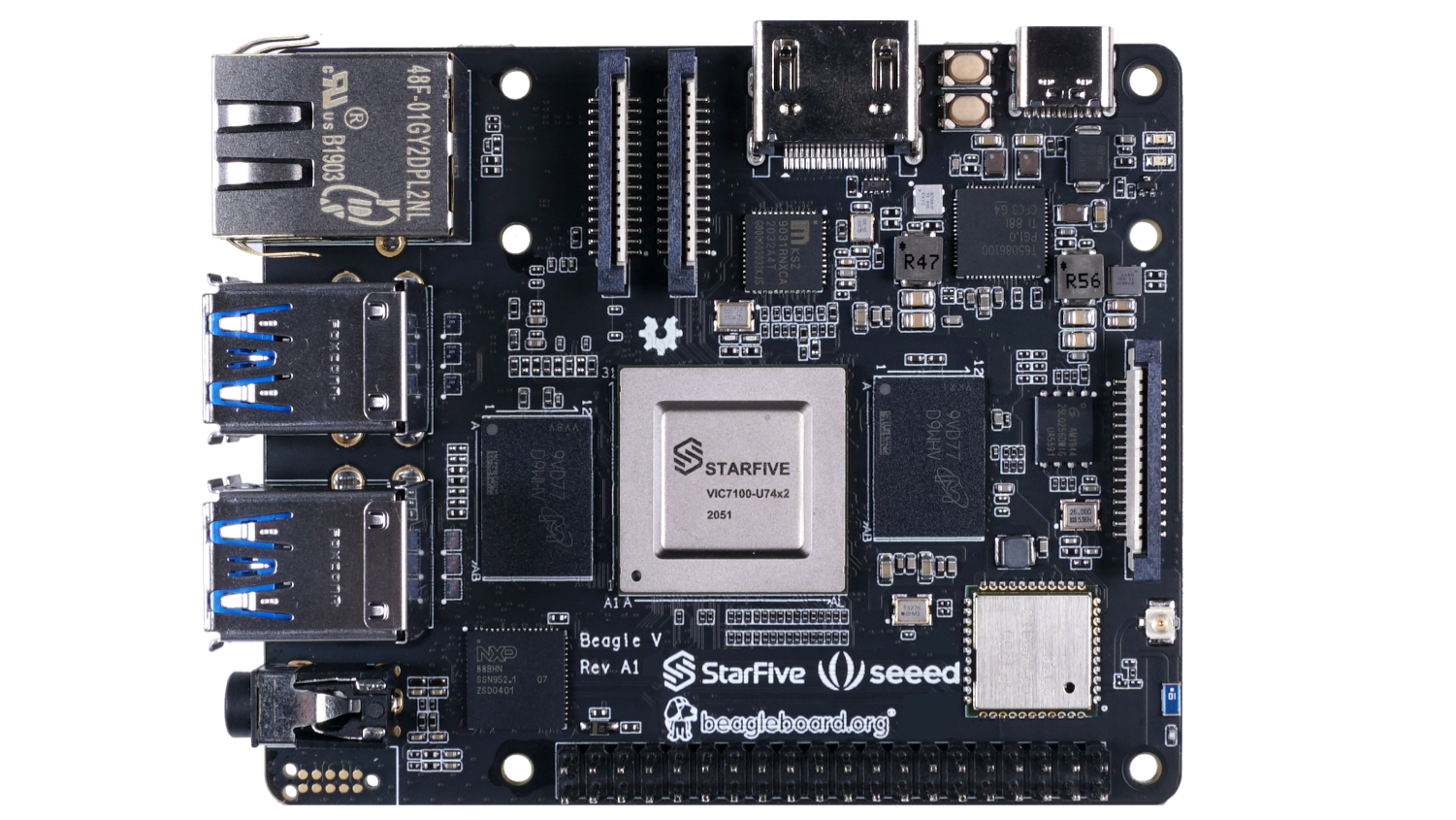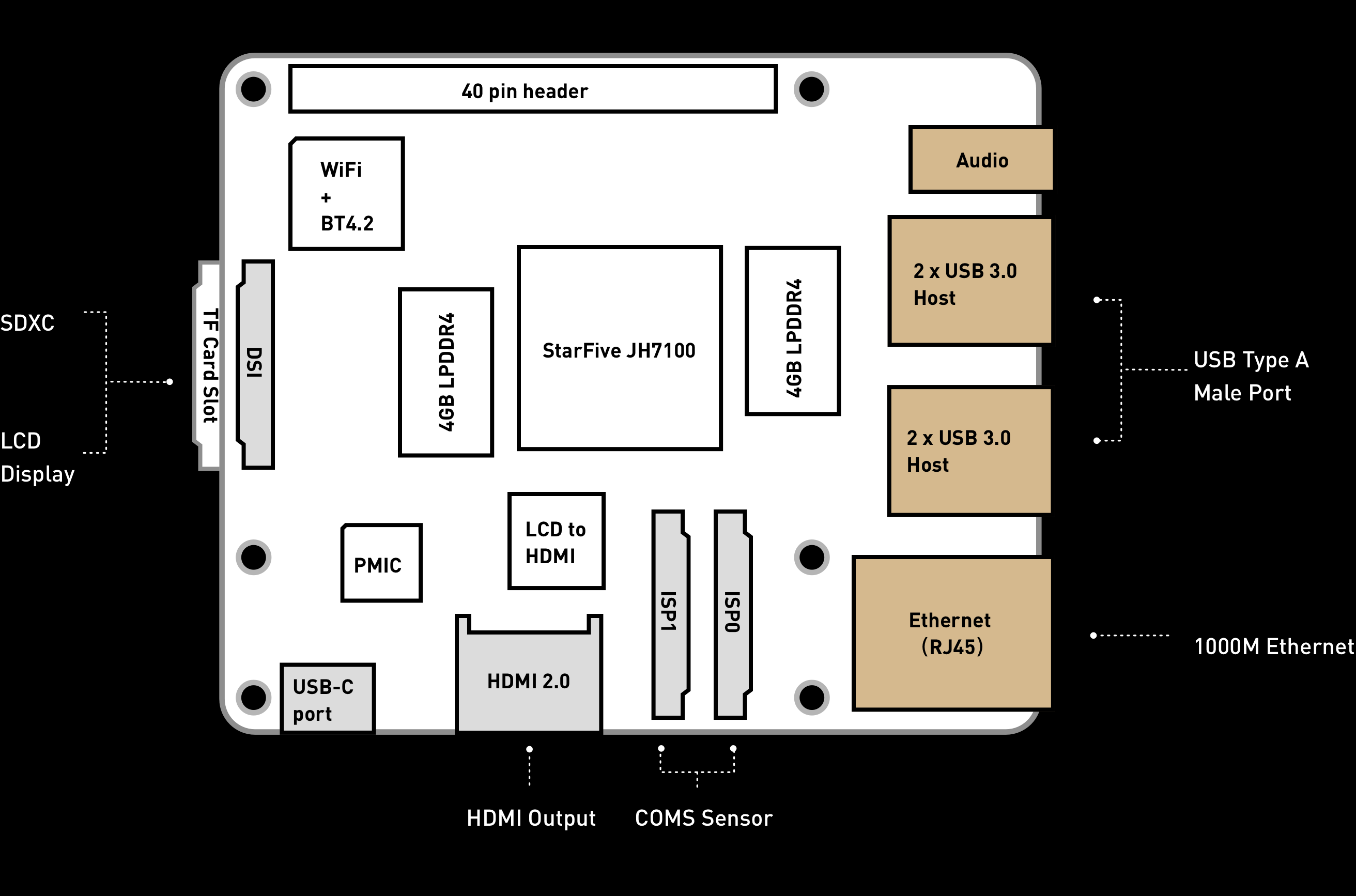RISC-V Powered BeagleV Board Announced Via New Collaboration
Open source hardware for the masses
The RISC-V CPU architecture is making progress across a plethora of devices. From soldering irons and watches to desktop computers, the open source RISC-V CPU looks set to make an impact in 2021. Seeed Studio and Beagleboard have today announced an official collaboration with StarFive, a leading RISC-V solutions provider. The focus of this announcement is the Beagle V, an affordable single board computer (SBC) which runs Linux and is powered by a dual core RISC-V.


Powering Beagle V is a dual core 64-bit U74 RISC-V CPU clocked at 1.5 GHz and up to 8GB of LPDDR4 RAM. From a CPU perspective Beagle V looks to be slightly faster than a Raspberry Pi 4, but looking at the StarFive JH7100 System on Chip (SoC) we can see a Tensilica-VP6 used in computer vision projects, an Nvidia Deep Learning Accelerator (NVDLA) used for artificial intelligence and finally a Neural Network Engine. All of these point towards a board that looks on paper to be quite the AI / machine learning powerhouse. Best of all Beagle V is a purely open source product, with both the hardware and the software offered under an open source licence.
| Processor | SiFive U74 RISC-V Dual core with 2MB L2 cache @ 1.5GHz |
| Row 1 - Cell 0 | Vision DSP Tensilica-VP6 for computing vision |
| Row 2 - Cell 0 | NVDLA Engine (configuration 2048 MACs@800MHz ) |
| Row 3 - Cell 0 | Neural Network Engine (1024MACs@500MHz) |
| Memory | 8GB LPDDR4 (2 x 4GB LPDDR4 SDRAM) |
| Video Processing | Video Decoder/Encoder(H264/H265) up to 1 channel 4K@60FPS or 8 channel 1080p@30FPS |
| Row 6 - Cell 0 | Dual channels of ISP, each channel support up to 4K@30FPS |
| Row 7 - Cell 0 | 2 x MIPI-CSI, 1 x MIPI-DSI |
| Row 8 - Cell 0 | 1 x HDMI support up to 1080P@30FPS |
| Row 9 - Cell 0 | Support MIPI-CSI TX for video output after ISP and AI processing |
| Row 10 - Cell 0 | JPEG Encoder/Decoder |
| Peripherals | 4 x USB 3.0 Ports |
| Row 12 - Cell 0 | 1 x Gigabit Ethernet |
| Row 13 - Cell 0 | 1 x 3.5mm Audio jack |
| Row 14 - Cell 0 | 40 Pin GPIO Header (28 x GPIO, I2C, I2S, SPI, UART) |
| Row 15 - Cell 0 | MicroSD card slot for operating system and data storage |
| Row 16 - Cell 0 | 1 x Wi-Fi 2.4GHz b/g/n and Bluetooth 4.2 |
| Row 17 - Cell 0 | Power with USB Type-C (5V@3A) |
| Row 18 - Cell 0 | 1 x Reset button and 1 x Power Button |
At its heart, Beagle V is still an SBC and as such it has what we come to think as the "standard complement" of ports. With four USB 3.0 ports, Gigabit Ethernet, Micro SD card and a single HDMI port, capable of 1080P 30fps. A 40 pin GPIO suggests compatibility with Raspberry Pi HATs, and a casual glance at the pinout shows that the standard digital I/O, I2C and SPI seem to be mapped correctly. Dual camera (CSI) and a single display connector (DSI) suggest that Beagle V may be compatible with the official Raspberry Pi camera and display. Wireless connectivity is provided via 2.4 GHz WiFi and Bluetooth 4.2. A shame that 5 GHz WiFi and Bluetooth 5.0 are not present, but we can live without it. Power is provided via a USB-C port, and from the datasheet we can see that Beagle V requires 5V at 2A but a 3A supply would be a real benefit.
Starting from $119 for the 4GB model, or $149 for the 8GB, Beagle V is slightly more expensive than a Raspberry Pi 4 but for RISC-V and AI enthusiasts this is a small price to pay for a RISC-V machine of such power. With an anticipated early access release date of March, with larger availability from September 2021, Beagle V looks to be a worthy contender to the Nvidia Jetson for AI and machine learning projects. It may not be a direct competitor to the Raspberry Pi, but it will be interesting to put the two against one another to see both of their pros and cons.
Get Tom's Hardware's best news and in-depth reviews, straight to your inbox.

Les Pounder is an associate editor at Tom's Hardware. He is a creative technologist and for seven years has created projects to educate and inspire minds both young and old. He has worked with the Raspberry Pi Foundation to write and deliver their teacher training program "Picademy".
-
jcalvarez The U74 seems to be quite a bit slower than the Cortex A72 used in the Raspberry Pi, also dual core vs quad core, and twice the price for the 4GB. If they want to widen the audience for RISC-V, they why to make the board so expensive?Reply -
wkussmaul Replyjcalvarez said:The U74 seems to be quite a bit slower than the Cortex A72 used in the Raspberry Pi, also dual core vs quad core, and twice the price for the 4GB. If they want to widen the audience for RISC-V, they why to make the board so expensive?
There's no way they can compete on price at this early stage. The product is for developers and others who see the future of RISC-V and want to start building on it so that when Beagle's RISC-V volumes start to build and prices come down, the foresighted developer will have products in, and experience with, the ecosystem.